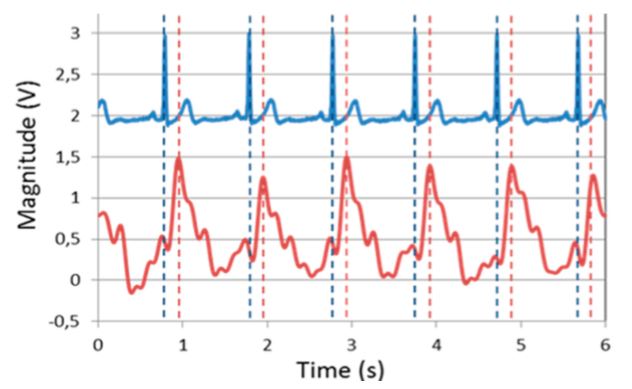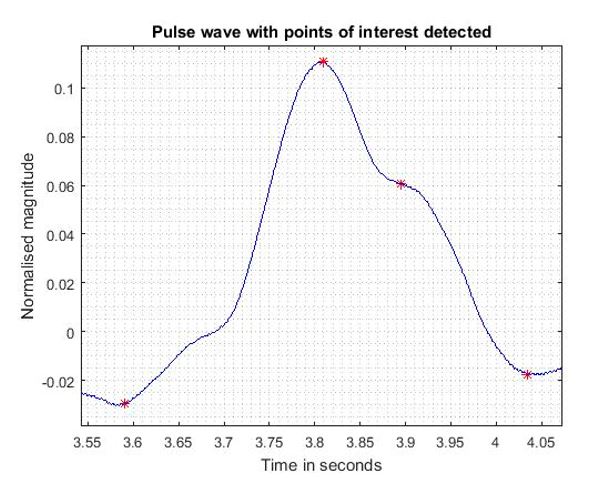ABSTRACT
The work presented in this paper concerns the design, fabrication and test of a simple portable device able to measure in real time the cardiac frequency and the pulse wave, plus the pulse velocity in specific conditions (carotid and femoral locations). The sensing part is based on a thin film technology embedded in polymer and the data processing part is based on a classical pre-amplifying circuit associated with digitalization and shape detection algorithm.
The whole device has been chosen as one demonstrator in the every where project of the PROXIMA mission launched by the European Space Agency, the France’s space agency CNES with space medicine specialists MEDES, to estimate the arterial stiffness variations under microgravity conditions and weightlessness. Raw data are stored through the remote tablet application and will be later processed using Matlab.
MATERIALS AND METHODS
The operation principle of our tonometer is based on deformation measurement due to the pulse pressure transit in the artery using a piezoelectric thin film and is conceived as a second skin solution. Indeed, the sensing unit is a disposable patch embedded in a polymer, while the electronic patch is hosting the power management, the microprocessor and memory, and the antennae in a reusable chip, Figure 1.

Figure 1. Principle of second skin concept
For monitoring and data processing, a control electronic and a Human Machine Interface (HMI) were developed. A charge amplifier stage and a 4-order low-pass filter for signal pre-conditioning compose the control electronic analog front end. The cut-off frequency of the filter was set at 25 Hz. The signals are digitalized using a 10-bit Analog-to-Digital converter embedded in the microcontroller used (Atmega328p) and transmitted by serial communication to the interface. The HMI developed in this study allows monitoring, recording and post-processing of pulse wave sequences from the piezoelectric sensor, Figure 5.

Figure 5. Example of the human machine interface developed to extract the main arterial characteristics
RESULTS
We fabricated several sensor prototypes which were the used for measurement on healthy volunteers, aged between 20 and 60 years old, male and female. First, a comparison with classical electrocardiogram (ECG) was done to both validate our measurements and offer the opportunity to synchronize the pulse wave form on a single reference, as illustrated on Figure 6.

Figure 6. Comparison between classical ECG (blue) with our sensor (red) measuring the pulse wave
The result is shown on Figure 8 for one pattern. The detected dots allow extracting cardiovascular parameters such as heart rate, systolic and diastolic cycles and the reflection index and reflection duration of the pulse wave directly related to arterial stiffness. After determining the foot of each wave, we will be able to determine the pulse wave velocity (PWV) from two measurements on two different locations (carotid-femoral). This requires either two simultaneous measurements (thus two sensors) or two measurements with the same sensor but with an ECG signal taken as reference for each measurement. The accurate PWV determination is one of the perspectives of this work.

Figure 8. Pulse wave with points of interest detected
CONCLUSIONS
Arterial stiffness detection is of high interest in cardiology. An accurate measurement method used to extract the blood pulse wave with a simple small size system compared to medical tonometer was demonstrated. Further developments will focus on the pulse velocity calculation based on measurement done at two locations.
Source: University Paris Est
Authors: Gaelle Lissorgues | Alexandre Bongrain | Lionel Rousseau | Nadia Madaoui | Amandine Testi | Laurie Valbin | Sébastien Moussay | Pierre-alexandre Chapon
>> Antenna Digital Processing IEEE Projects for Engineering Students
>> 50+ Matlab projects for Digital Image Processing for Final Year Students
>> Matlab Projects Fingerprint Recognition and Face detection
>> More Analog Communication Projects using Matlab for Engineering Students